This weekend we attended Fleet Week Port Everglades as a guest of Mike Chan, Protocol Officer with Navy Region Southeast, who was organizing the event.
We arrived shortly before the Legion of Honor Ceremony on board the USS Bataan, where the Consulate General of France, Philippe Létrilliart, awarded nine American veterans with the Legion of Honor Medal for their heroic actions during the 1944 landings at Normandy. “We will never forget what you did for us”, Mr. Létrilliart, who is from Normandy, said during the emotional ceremony. One near-centurion was in the group of honorees, but most were in their teens or barely beyond when they struggled ashore under heavy fire to take the beach. Their success began the liberation of France and northwestern Europe. We had an opportunity to meet several of the honorees after the ceremony. One veteran had visited all fifty states, mostly by motorhome, and was quite interested in our travels as well.
Click Facebook “f” button at lower right if video below won’t play.
We later went on a tour of the USS Bataan. The 844 ft assault ship is simply massive. To give an idea of scale, the door visible at the far left end of the hanger bay below is big enough for a AV-8B Harrier attack plane to wheel out onto an elevator for lifting onto the flight deck above.
The next deck down (shown in the bottom right of the three pictures below) houses tanks, armored personal carriers, and heavy-duty trucks.
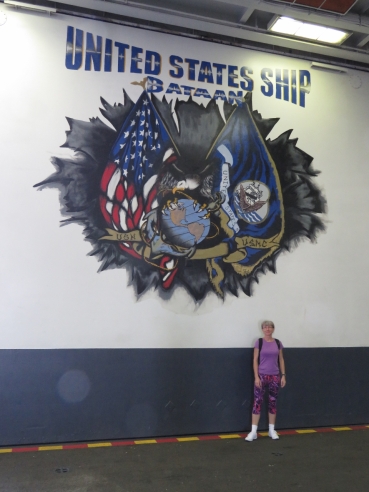
|
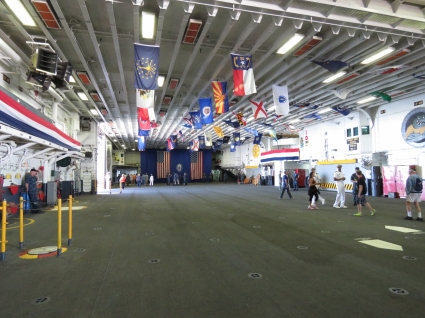
|

|
The Bataan is an amphibious assault ship with a well deck at the stern. In the well deck was a 91-ft amphibious assault craft with a 47-ft beam that can travel over 50 knots. The assault craft has a cargo-carrying capacity of 72 tons and can transport any vehicle we saw that day on the Bataan, including 70-ton tanks. In the group of four pictures below, the top two are of the amphibious assault craft. On the lower left is a LARC-V (Lighter, Amphibious Resupply, Cargo, 5 ton) that also is amphibious. The lower right picture shows two of the amphibious assault craft at speed.
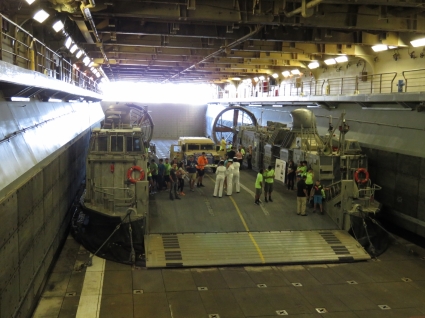
|

|
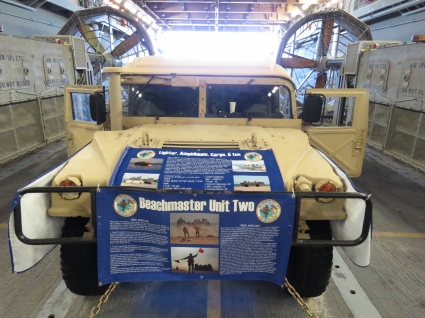
|
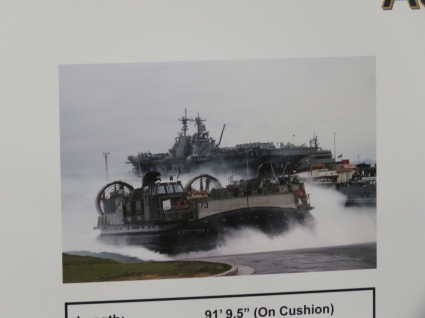
|
Mike Chan (on James’ left in the photo below) had arranged for us to join the VIP tour of the Bataan, with the French Consulate General Philippe Létrilliart (to James’ right), and Admiral Kurt Tidd, Commander, U.S. Southern Command and guest speaker for the Legion of Honor ceremony (in dress whites opposite James). Admiral Tidd had detailed answers for questions on the Bataan and the transport and weapons systems it carried. He was very generous with his time, stopping frequently so sailors and members of the general public could have a picture beside him.
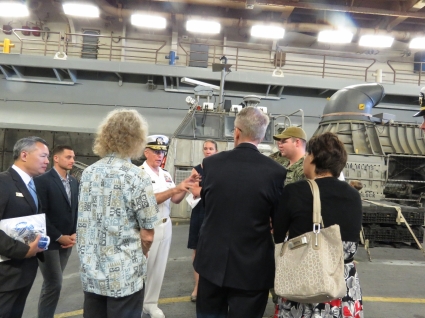
|
On the flight deck, we toured a Sikorsky CH-53E Super Stallion, the U.S. military’s largest and heaviest helicopter. This one belongs to Marine Heavy Helicopter Squadron 464 (HMH-464), known as the “Condors”. The CH-53E is a heavy-lift cargo helicopter that can carry 55 passengers, or 13.6 tons of cargo internally and an additional 14.5 tons slung underneath. It can lift, for example, an entire LAV-25 armored personal carrier or a M198 howitzer towed artillery gun with crew and ammunition.
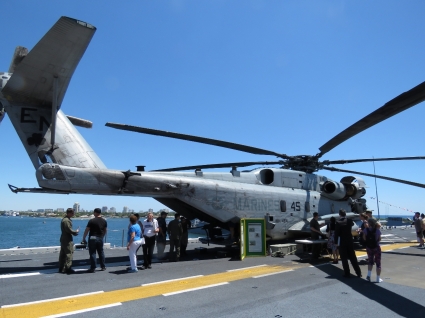
|

|
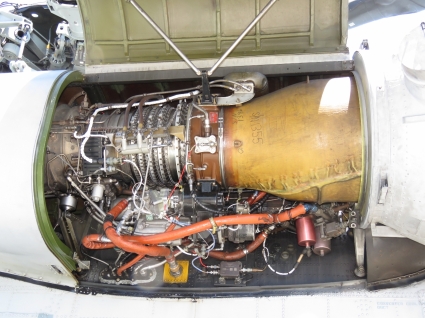
|

|

|
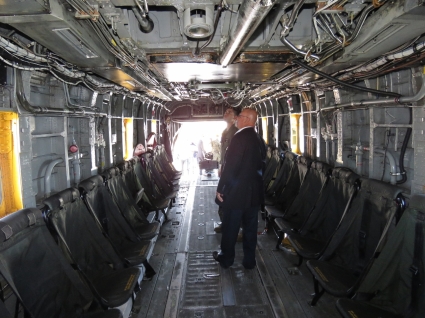
|
Next up was Primary Flight Control, with an impressive view across the ship. The Air Boss and the Mini-Boss, who are responsible for all flight deck operations on the Bataan sit just to the right of where Jennifer is looking in. The Bataan doesn’t have a deck long enough for conventional fighters, but does support AV-8B Harrier II attack planes that can make vertical or short take-offs and landings. Portions of the deck are surfaced with a special heat-resistant material that can sustain the enormous heat from a jet engine aimed straight down. The video below the flight deck photos shows U.S. Marine Corps Capt. William Mahoney making an incredible no-gear landing of an AV-8B on the Bataan.

|
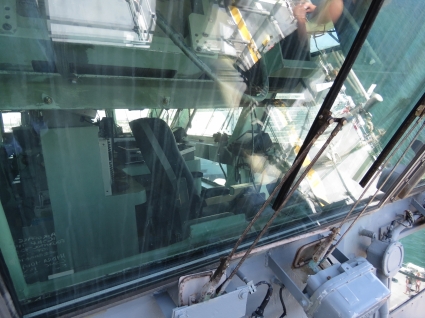
|

|

|
The bridge is at the same level as Primary Flight Control. Jennifer tried out the Commanding Officer’s seat on the bridge. It’s the only seat on the Bataan with a better view than that of the Air Boss.
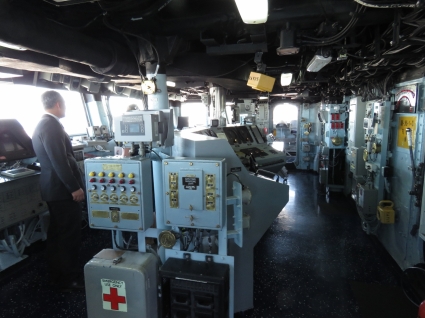
|
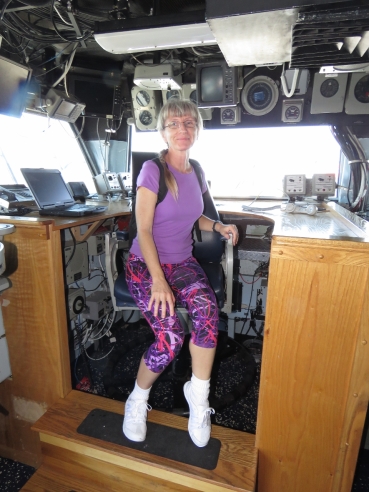
|
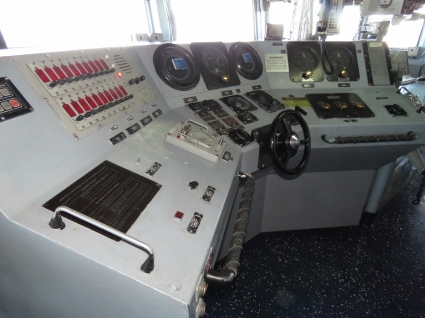
|
Coast Guard, Navy and local sheriff boats constantly patrolled the area, keeping out any unauthorized traffic.
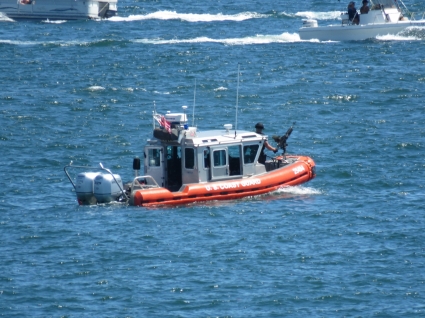
|
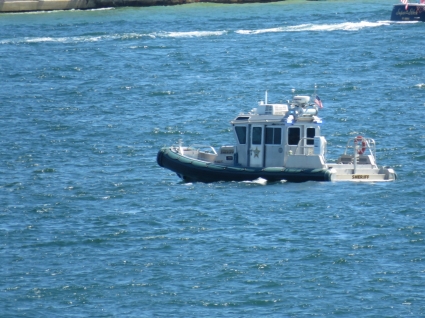
|
Back down inside the ship, we got a photo-op with a navy sniper. He offered to let Jennifer hold the gun for the photo, but it was way too heavy for her recovering shoulder.
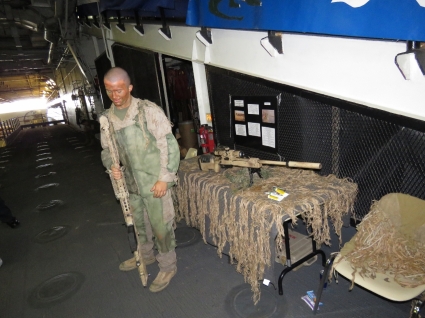
|
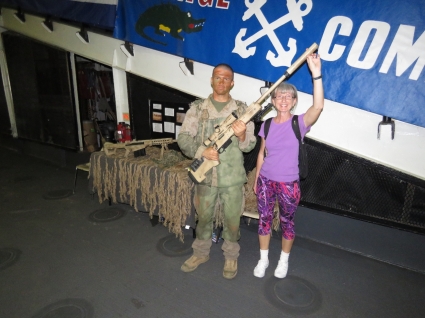
|
We spent ages talking to the crew of this M1 Abrams battle tank. Jennifer was determined to climb up to go inside, and the crew were accommodating and careful in helping her get on and off one-handed.
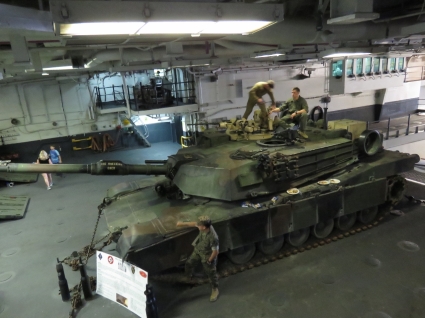
|
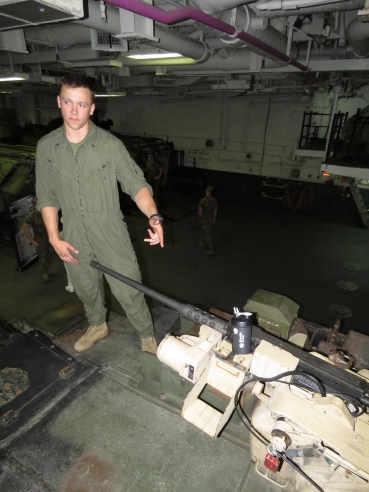
|
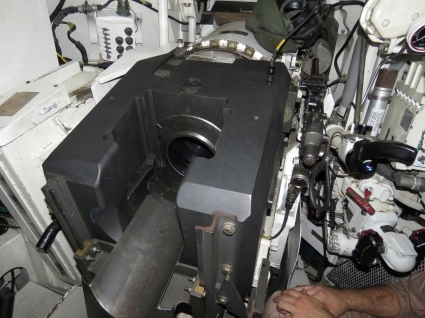
|
After the Bataan, we toured the nuclear-powered fast attack submarine USS California. The vessel is 377 feet long with a 34-ft beam, can reach speeds in excess of 25 knots and dive well below 800 feet. We’ve never been aboard a nuclear-powered vessel, so were really excited to get aboard this Virginia-class submarine that only just entered the service in 2011. The Virginia class are the most modern in the US fleet and believed to be quietest attack submarines in the world.
Photography is not permitted aboard the California, so we weren’t able to take any pictures inside on this visit. But we have great pictures coming. Not only do we have pictures inside the California, but we have the rarest of rare: pictures inside the California with James on-board while underway 500 feet below the ocean surface. James reports it was one of the most exciting trips ever. We’ll post the details later this week.
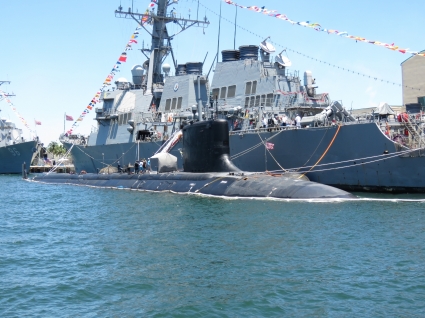
|

|
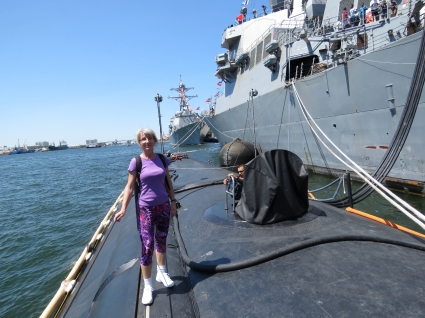
|

|
Our final tour of the weekend was on board the USS Cole. The Cole was commissioned in Port Everglades and many of her plankholders (original crew) continue to reside in South Florida. The ship was the target of a terrorist attack in October of 2000 that killed 17 sailors and injured 39. Two suicide bombers in a small fiberglass boat detonated 400-700 pounds of explosives against the port side of the ship, creating a 40-by-60-foot gash in the hull. Over a following three days, the crew fought flooding and controlled the damage, keeping the Cole afloat. It was later transported back to the US aboard a semi-submersible heavy lift salvage ship for repairs. A plaque on the machine gun above where the explosion occurred commemorates the installation of the 100th MK 32 Mod 2 Machine Gun System designed to defend Navy boats from small boat threats, and is dedicated to the sailors who lost their lives and their shipmates who saved the ship.
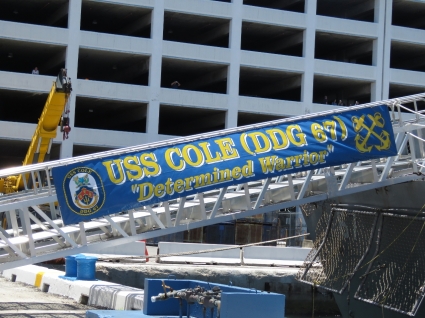
|
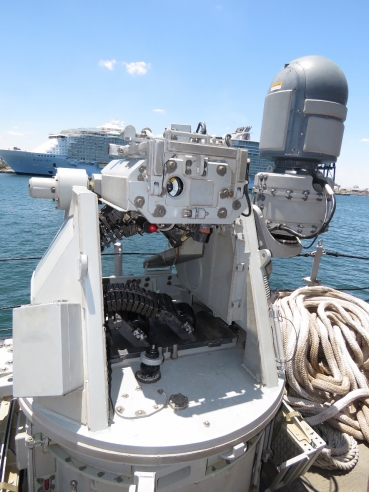
|
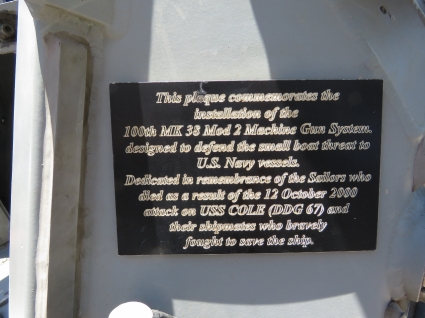
|
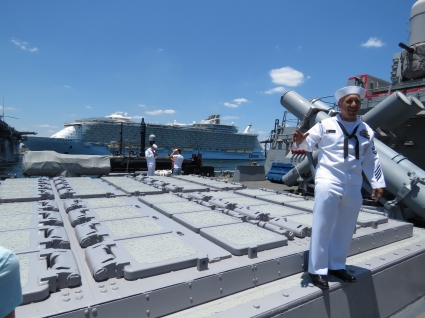
|
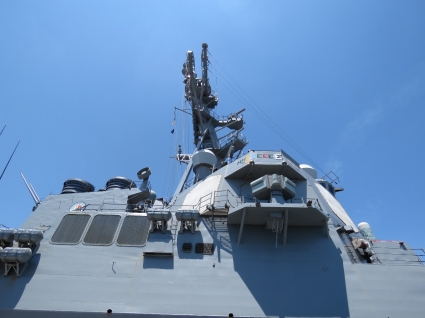
|
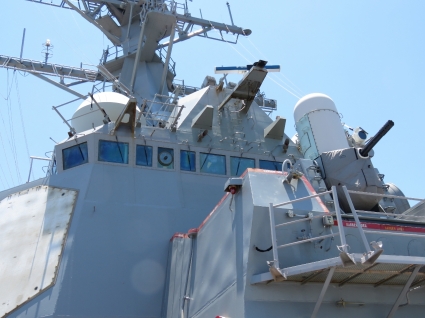
|

|
A view to the California and the Bataan from the deck of the Cole. The California was moored against and taking power from the Cole, and the sailor giving the tour joked that “California is powered by coal (Cole)”.
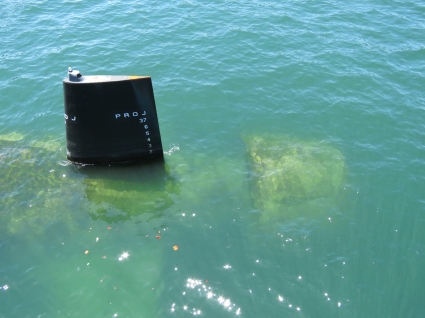
|
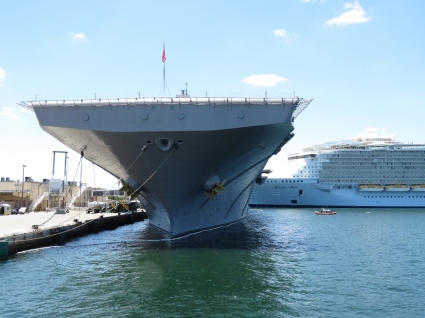
|
Thanks to Navy Protocol Officer Mike Chan for making this memorable and educational weekend possible.
This post is the 14th in the Technology series. Past posts have included the Holland America cruise ship Westerdam, the Australian ice breaker Aurora Australis, Richards Bay Minerals, the container ship Hanjin Oslo, and the 5,000HP tractor tug SL Herbert.


Thanks again for sharing James – you and Jennifer sure get into some interesting places!
Your insights on the USS Cole were especially meaningful. At GE, I eventually became the lead systems engineer for lead ship Arleigh Burke class destroyer machinery control systems – included propulsion, electric plant and damage control systems and my wife was in service and support.
Our equipment was heavily damaged during the attack but thanks to redundancy it survived and was able to keep major systems functional and maneuverable until they got her into the service vessel.
It was a somber day when the equipment finally made it back to our facility to be rehabilitated. Everyone stood silently as the cabinets made their way into the building as the reality of the attack hit home. No matter the damage there was no doubt those systems were going back into service.
The USS Cole is a striking symbol of the resiliency and dedication of our Navy service men and women. You are a lucky couple to have toured her.
We were actually supposed to be coming up FL east coast from the keys for the next two weeks and I was going to contact you, however, like Jennifer, my wife had an accident while in Naples (bike – nothing broken but a large hematoma emerged, preventing any further boating for a while) and we had to drive home. I’m heading back Monday with a buddy to bring the vessel home to St Petersburg.
I’d love to go aboard a Virginia Class Submarine. The 688(I) was the cutting edge when I was around for a fast attack.
If you are interested in submarines a very good book on the subject is “Blind Man’s Bluff” written by Sherry Sontag, Christopher Drew and Annette Lawrence Drew.
Being on an ASR we were attached to a Submarine Development Group (SUBDEVGRU ONE) and I got to see a few but I missed out on going on a “Boomer”.
What I loved about the book is we’d done some rather strange stuff and there where several parts where things clicked and finally made sense.
Your time attached to SUBDEVGRU ONE sounds like a very cool job. I’ll bet there was lots to see.
After spending some time aboard the California, I’m super interested in learning more and will take your advice and pick up Blind Man Bluff. Thanks for the pointer.
It wasn’t any more interesting than any other place in the U.S. Navy or the Military in general. Obviously I got to see and play with more “neat” things than most people do if you are into certain types of technology.
The book is about U.S. Submarine operations during the cold war. There was actually very little of which, I was aware of at the time. It was just fun reading a book and suddenly realizing the purpose of several of the things we did do even if it was 30 years later.
While I spent 23 years in the Navy as a Surface Warfare Office, I whole heartedly endorse Blind Man’s Bluff. A fantastic book and very well researched.
Probably time to pull my copy off the shelf and read it again.
I picked up a Kindle copy of Blind Mans Bluff yesterday. It’s annoying that the publisher (Hatchette Group) charges 15.99 for an electronic copy which is nearly free to distribute and 10.99 for a manufactured paperback version that does have significant manufacturing and distribution costs. There are good publishers out there but the the publishing world is a group of monopolies where each title is owned by a single publisher. There is some competition to sign authors if they are established naes but, after that, it’s a monopoly where the author has no immediate alternative and the buying public never has any alternative. I normally wouldn’t care since I don’t publish myself but $15.99 for an electronic copy of an book published in 1998 is crazy high and charging more than a paperback is just silly.
If I ever do write a book, it won’t be published by Hatchette. This is an industry that needs to get a bit more customer friendly and step into this century.
Thanks for the book recommendation. I’m looking forward to it.
As I was re-reading your post as it concerned the California, I have no doubt it, and the Sea wolf class are the premier Air Independent Propulsion (AIP) submarines on this planet. I also doubt they are the quietest under certain situations.
The Germans (go figure) or maybe even the Swedes probably hold that distinction. They however are not using a nuclear power source which for tactical purposes is self contained and virtually limitless.
A diesel/electric boat running on batteries if everything else is set up right is extremely hard to beat when it comes to sound.
The strength for any submarine is it’s ability to remain undetected. Once detected they can be relatively easy to track down and destroy.
As you well know from your experience with batteries on Dirona a submarine running on batteries, once found is not going to go anywhere.
An AIP submarine such as the California on the other hand can dive far enough to find a good thermal in which to hide, and move extremely fast for as long as necessary enabling them to move outside the search pattern.
If you take one of your charts and mark a spot on the map and consider that as a hard contact for a submarine. That’s all fine and dandy if whatever found it is able to prosecute the target at that time however, what if it takes something 15 mins to get a helicopter, or some other aircraft or surface unit to respond?
Now from your point on the map draw a circle 13 miles in diameter. That now represents the area necessary to search to nail down that submarine. If that unit wastes 15 mins with no contact increase that circle to 26 miles. An hour, make it 52 miles.
Then throw in the variables of did they decide to simply run flat out, maybe something in between, or attempt to hide on a different side of any thermal from which you are searching? Are they moving away or toward whatever it is you are trying to protect.
I have no doubt that the California operating on natural convection is extremely quiet but, it’s the unlimited ability to move fast that makes a nuke boat like the California extremely dangerous.
It is true that there is a real tension in submarine design between the design goals stealth, speed, and depth capability. Faster usually negatively impacts speed. Depth requires a thicker, heavier pressure hull which will require more buoyancy to be able to achieve neutral buoyancy. It’s reported that some older Russian submarines got their speed by sacrificing reactor shielding and crew safety. I suspect it’s quite a puzzle to find the right mix and I don’t doubt you are correct that speed is a very important dimension and one of the real advantages of nuclear powered subs over diesel designs which can be very quiet.
The core of Soviet nuclear submarines (those I know anything about anyway) was a liquid metal cooled reactor. Smaller in size and able to produce much higher vapor temperatures they do have some “interesting” maintenance challenges. That’s really the basis for the ability of several Soviet classes to “haul the mail”
In several classes any reduction on reactor shielding on those boats would have been offset by the use of a double pressure hull as far as design factors relating to speed.
I’m not sure if reduced shielding was a much of a safety factor as protocol, training, motivation, and quality control.
Rickover was insane about reactor safety and many of the systems are vastly over engineered, and training at least under his watch, was extremely detailed. I doubt anything has changed and would be surprised to hear that it had.
I would never argue that was a bad thing however it did negatively effect some design aspects of U.S. Submarines. The fruit of his labors can be seen in the fact I’ve never heard of a reactor accident on a U.S. Submarine. There could easily have been minor problems, but anything major, all of us would have heard about by now.
You got to see the crew of the California in action, those are some of the most highly trained and motivated individuals on the planet.
Considering what I’ve heard about the “Perisher” course, you can bet the British are no slouches either.
I know you are right that Rickover’s conservationism has reduced the potential capabilities of Navy boats when compared to the absolute limits. But, one argument in favor of his extraordinary focus on nuclear safety that continues to influence the nuclear navy is the US public is, for the most part, not frightened of the Navy carriers and submarines and hasn’t been campaigning to shut them down.
Three Mile Island, Chernobyl, and more recently Fukishima have made it very difficult to build nuclear power reactors in many countries. Here in the US we went 19 years without approving a new build licenses largely on the public backlash from Three Mile Island and errors in other countries.
Bloody amazing! Thanks for the insight guys.
It was an awesome visit. And, we have one more blog entry comming covering what I thought was the pinacle of the trip: underway on the USS California (SSN-781).
James, Thanks for the tour and what a fantastic opportunity. I cant wait for the stuff on your Capt Nemo adventures on the USS Cole, you couldn’t buy a ticket for that. Its comforting to know the capabilities of our best friend and ally the US. We might not have the same firepower and materiel but I’m told we punch above our weight helping you guys in the Middle East.
You are so right Gary. Australia’s contribution to war efforts and peace keeping have spanned far more than a century. Nothing drove that point home better than our visit to Australia’s Memorial Walk (at the North Head Sanctuary in Manley) where they commemorate Australia’s defense contribution dating back prior to World War I.
The chance for me to go out on a Virginia class submarine was a once in lifetime opportunity. The California is the first of the class and it’s very recent technology having only just been launched in 2011. It really is an incredible work of technology.
Kindle is bad about that, however I didn’t know if it was Kindle or the Author.
I bought Ken Williams book on the GSSR and would have bought more and a at least one James Ellingford has out however, while I enjoyed the GSSR “book” it was really just a poorly edited copy of Ken’s blog.
The several page samples offered by both authors on other books were unable to spark my interest for the price Kindle was asking.
If I had known you were that interested, I’d have sent you my copy. I’ve read it twice over the years I doubt I’ll read it again and so far haven’t found anyone else that wants to either.
It seems people that read books for entertainment are a dying breed, charities and libraries (at least around here) don’t want them, and I hate to just throw them away.
That is the nice thing about a Kindle, they take up so little space.
Unfortunately, it’s the publisher setting the prices. I understand your unwillingness to pay some of the prices asked in the Kindle marketplace. In my opinion, there is nothing wrong with being selective about what you read at least partly based up on prices. “Voting with your pocket book” is one of the best ways to influence large company pricing policies.